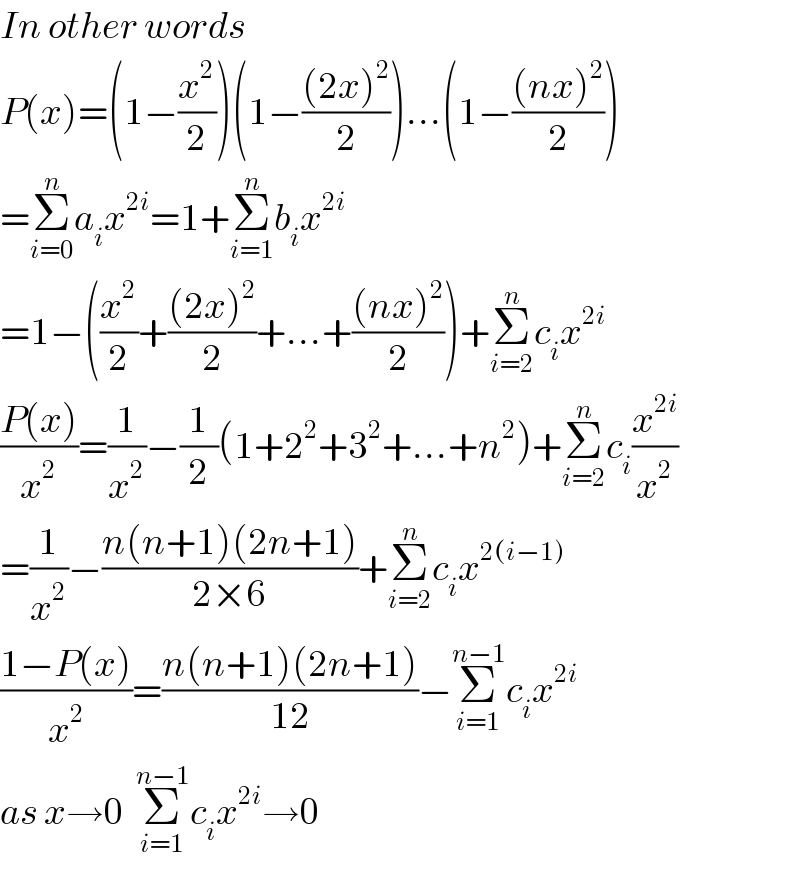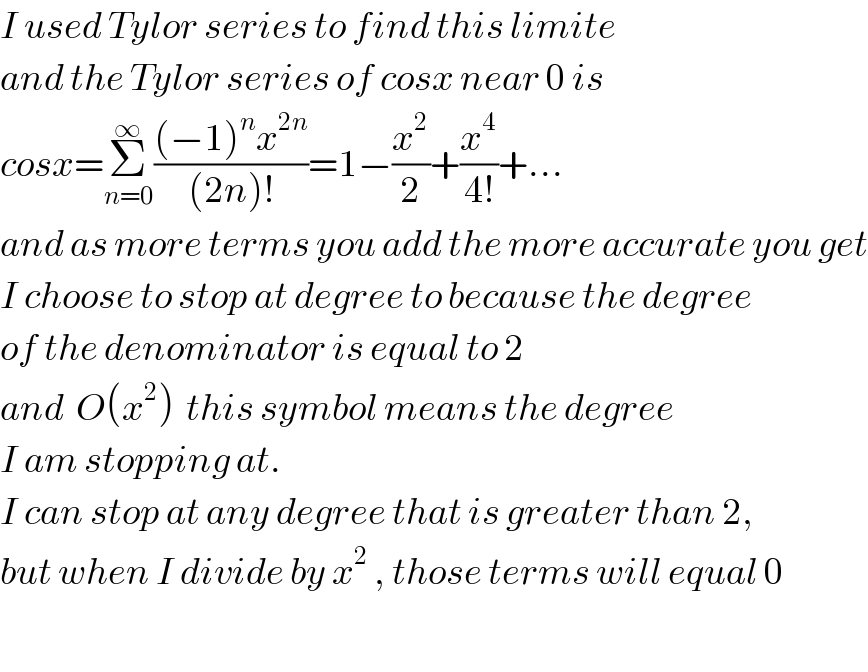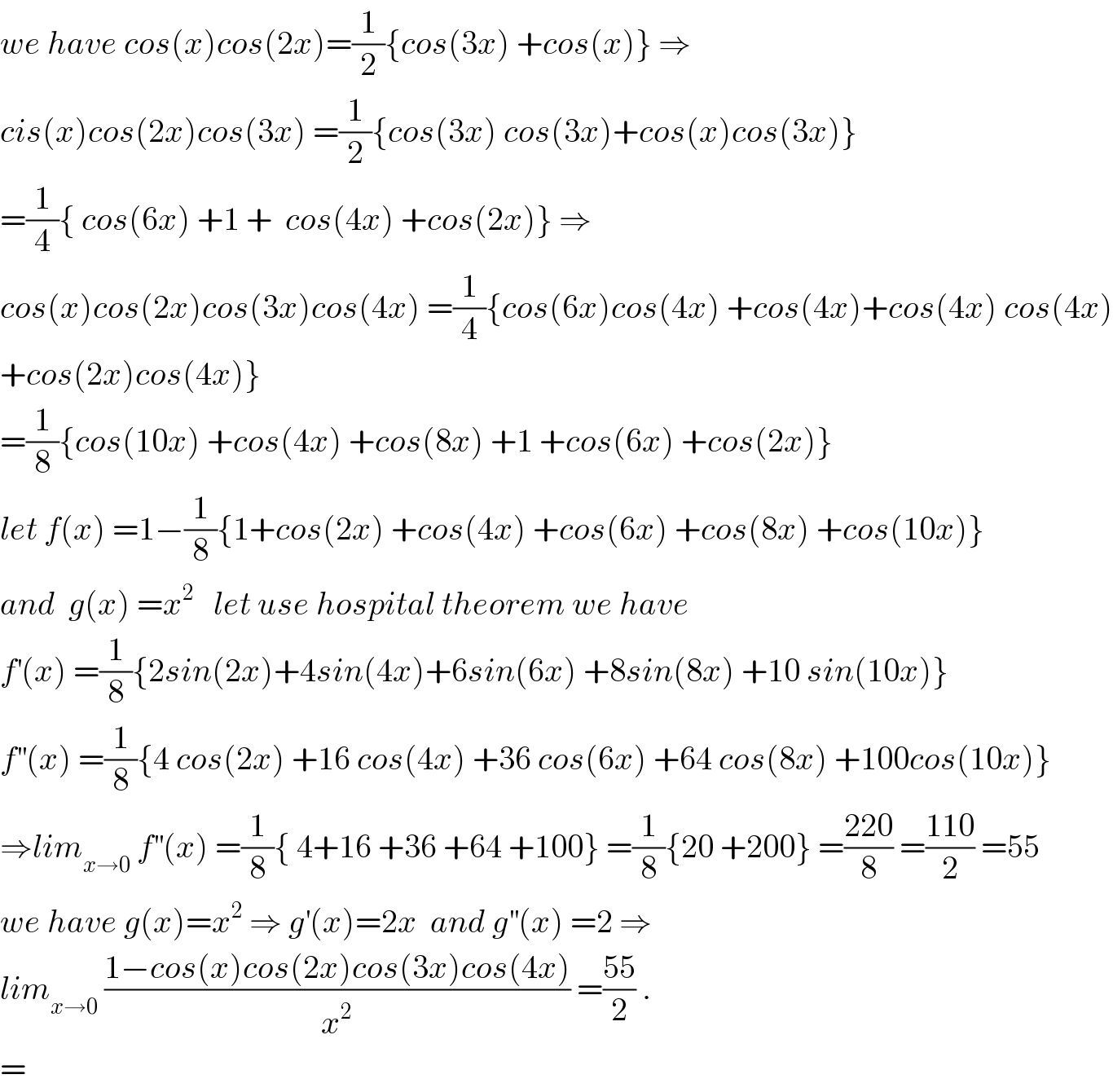
Question Number 58267 by salahahmed last updated on 20/Apr/19
![lim_(x→0) [((1−cos (x)cos (2x)cos (3x)cos (4x))/x^2 )]](Q58267.png)
$$\underset{{x}\rightarrow\mathrm{0}} {\mathrm{lim}}\:\left[\frac{\mathrm{1}−\mathrm{cos}\:\left({x}\right)\mathrm{cos}\:\left(\mathrm{2}{x}\right)\mathrm{cos}\:\left(\mathrm{3}{x}\right)\mathrm{cos}\:\left(\mathrm{4}{x}\right)}{{x}^{\mathrm{2}} }\right] \\ $$
Commented by Smail last updated on 20/Apr/19

Commented by Smail last updated on 20/Apr/19

$${When}\:\:{n}=\mathrm{4} \\ $$$$\underset{{x}\rightarrow\mathrm{0}} {{lim}}\frac{\mathrm{1}−{cosxcos}\left(\mathrm{2}{x}\right){cos}\left(\mathrm{3}{x}\right){cos}\left(\mathrm{4}{x}\right)}{{x}^{\mathrm{2}} }=\frac{\mathrm{4}\left(\mathrm{4}+\mathrm{1}\right)\left(\mathrm{4}×\mathrm{2}+\mathrm{1}\right)}{\mathrm{12}} \\ $$$$=\frac{\mathrm{180}}{\mathrm{12}}=\mathrm{15} \\ $$
Commented by maxmathsup by imad last updated on 20/Apr/19

$${sir}\:{smail}\:\:{why}\:\left(\mathrm{1}−\frac{{x}^{\mathrm{2}} }{\mathrm{2}}\right)\left(\mathrm{1}−\frac{\left(\mathrm{2}{x}\right)^{\mathrm{2}} }{\mathrm{2}}\:\right)...\left(\mathrm{1}−\frac{\left({nx}\right)^{\mathrm{2}} }{\mathrm{2}}\right)+{o}\left({x}^{\mathrm{2}} \right) \\ $$$$=\mathrm{1}−\left(\frac{{x}^{\mathrm{2}} }{\mathrm{2}}\:+\frac{\left(\mathrm{2}{x}\right)^{\mathrm{2}} }{\mathrm{2}}\:+.....+\frac{\left({nx}\right)^{\mathrm{2}} }{\mathrm{2}}\right)\:+{o}\left({x}^{\mathrm{2}} \right).... \\ $$
Commented by Smail last updated on 21/Apr/19

$$\mathrm{1}\:{coms}\:{from}\:\:\mathrm{1}\:{times}\:\mathrm{1}\:{times}\:\mathrm{1}...{n}\:{times} \\ $$$${and}\:\:\left(\frac{{x}^{\mathrm{2}} }{\mathrm{2}}+\frac{\left(\mathrm{2}{x}\right)^{\mathrm{2}} }{\mathrm{2}}+...\frac{\left({nx}\right)^{\mathrm{2}} }{\mathrm{2}}\right)\:\:{comes}\:{from}\:\mathrm{1}\:{times}\:\:{each}\:{term}\:{whose}\:{degree}\:{is}\:{equal}\:\mathrm{2}. \\ $$$${However},{I}\:{am}\:{not}\:{interested}\:{in}\:{the}\:{other}\:{terms}\:{whose}\:{degree} \\ $$$${are}\:{greater}\:{than}\:\mathrm{2}\:{because}\:{when}\:{I}\:{divide} \\ $$$${everything}\:{by}\:\:{x}^{\mathrm{2}} ,\:\:{the}\:{terms}\:{whose}\:{degree} \\ $$$${are}\:{greater}\:{than}\:\mathrm{2}\:\:{will}\:{equal}\:\mathrm{0}\:{since}\:{x}\rightarrow\mathrm{0} \\ $$
Commented by Smail last updated on 21/Apr/19

$${In}\:{other}\:{words}\: \\ $$$${P}\left({x}\right)=\left(\mathrm{1}−\frac{{x}^{\mathrm{2}} }{\mathrm{2}}\right)\left(\mathrm{1}−\frac{\left(\mathrm{2}{x}\right)^{\mathrm{2}} }{\mathrm{2}}\right)...\left(\mathrm{1}−\frac{\left({nx}\right)^{\mathrm{2}} }{\mathrm{2}}\right) \\ $$$$=\underset{{i}=\mathrm{0}} {\overset{{n}} {\sum}}{a}_{{i}} {x}^{\mathrm{2}{i}} =\mathrm{1}+\underset{{i}=\mathrm{1}} {\overset{{n}} {\sum}}{b}_{{i}} {x}^{\mathrm{2}{i}} \\ $$$$=\mathrm{1}−\left(\frac{{x}^{\mathrm{2}} }{\mathrm{2}}+\frac{\left(\mathrm{2}{x}\right)^{\mathrm{2}} }{\mathrm{2}}+...+\frac{\left({nx}\right)^{\mathrm{2}} }{\mathrm{2}}\right)+\underset{{i}=\mathrm{2}} {\overset{{n}} {\sum}}{c}_{{i}} {x}^{\mathrm{2}{i}} \\ $$$$\frac{{P}\left({x}\right)}{{x}^{\mathrm{2}} }=\frac{\mathrm{1}}{{x}^{\mathrm{2}} }−\frac{\mathrm{1}}{\mathrm{2}}\left(\mathrm{1}+\mathrm{2}^{\mathrm{2}} +\mathrm{3}^{\mathrm{2}} +...+{n}^{\mathrm{2}} \right)+\underset{{i}=\mathrm{2}} {\overset{{n}} {\sum}}{c}_{{i}} \frac{{x}^{\mathrm{2}{i}} }{{x}^{\mathrm{2}} } \\ $$$$=\frac{\mathrm{1}}{{x}^{\mathrm{2}} }−\frac{{n}\left({n}+\mathrm{1}\right)\left(\mathrm{2}{n}+\mathrm{1}\right)}{\mathrm{2}×\mathrm{6}}+\underset{{i}=\mathrm{2}} {\overset{{n}} {\sum}}{c}_{{i}} {x}^{\mathrm{2}\left({i}−\mathrm{1}\right)} \\ $$$$\frac{\mathrm{1}−{P}\left({x}\right)}{{x}^{\mathrm{2}} }=\frac{{n}\left({n}+\mathrm{1}\right)\left(\mathrm{2}{n}+\mathrm{1}\right)}{\mathrm{12}}−\underset{{i}=\mathrm{1}} {\overset{{n}−\mathrm{1}} {\sum}}{c}_{{i}} {x}^{\mathrm{2}{i}} \\ $$$${as}\:{x}\rightarrow\mathrm{0}\:\:\underset{{i}=\mathrm{1}} {\overset{{n}−\mathrm{1}} {\sum}}{c}_{{i}} {x}^{\mathrm{2}{i}} \rightarrow\mathrm{0} \\ $$
Commented by Tawa1 last updated on 21/Apr/19

$$\mathrm{What}\:\mathrm{is}\:\mathrm{O}\:\mathrm{sir} \\ $$
Commented by Tawa1 last updated on 21/Apr/19

$$\mathrm{I}\:\mathrm{mean},\:\:\:\mathrm{the}\:\:+\:\mathrm{Ox}^{\mathrm{2}} \\ $$
Commented by Tawa1 last updated on 21/Apr/19

$$\mathrm{And}\:\mathrm{why}\:\mathrm{do}\:\mathrm{you}\:\mathrm{chose}\:\mathrm{to}\:\mathrm{stop}\:\mathrm{at}\:\:\mathrm{power}\:\:\mathrm{2}\:\mathrm{sir} \\ $$
Commented by Smail last updated on 21/Apr/19

$${I}\:{used}\:{Tylor}\:{series}\:{to}\:{find}\:{this}\:{limite} \\ $$$${and}\:{the}\:{Tylor}\:{series}\:{of}\:{cosx}\:{near}\:\mathrm{0}\:{is} \\ $$$${cosx}=\underset{{n}=\mathrm{0}} {\overset{\infty} {\sum}}\frac{\left(−\mathrm{1}\right)^{{n}} {x}^{\mathrm{2}{n}} }{\left(\mathrm{2}{n}\right)!}=\mathrm{1}−\frac{{x}^{\mathrm{2}} }{\mathrm{2}}+\frac{{x}^{\mathrm{4}} }{\mathrm{4}!}+... \\ $$$${and}\:{as}\:{more}\:{terms}\:{you}\:{add}\:{the}\:{more}\:{accurate}\:{you}\:{get} \\ $$$${I}\:{choose}\:{to}\:{stop}\:{at}\:{degree}\:{to}\:{because}\:{the}\:{degree} \\ $$$${of}\:{the}\:{denominator}\:{is}\:{equal}\:{to}\:\mathrm{2} \\ $$$${and}\:\:{O}\left({x}^{\mathrm{2}} \right)\:\:{this}\:{symbol}\:{means}\:{the}\:{degree}\: \\ $$$${I}\:{am}\:{stopping}\:{at}. \\ $$$${I}\:{can}\:{stop}\:{at}\:{any}\:{degree}\:{that}\:{is}\:{greater}\:{than}\:\mathrm{2}, \\ $$$${but}\:{when}\:{I}\:{divide}\:{by}\:{x}^{\mathrm{2}} \:,\:{those}\:{terms}\:{will}\:{equal}\:\mathrm{0} \\ $$$$ \\ $$
Commented by maxmathsup by imad last updated on 21/Apr/19

$${thanks}\:{sir}\:{for}\:{this}\:{clarification}. \\ $$
Commented by Smail last updated on 21/Apr/19

$${You}\:{are}\:{welcome}\:{and}\:{I}\:{hope}\:{my}\:{comments}\:{were}\:{helpful}. \\ $$
Commented by Tawa1 last updated on 21/Apr/19

$$\mathrm{Now},\:\mathrm{i}\:\mathrm{understand}\:\mathrm{sir}.\:\mathrm{more}\:\mathrm{knowledge}. \\ $$
Commented by maxmathsup by imad last updated on 21/Apr/19

$${we}\:{have}\:{cos}\left({x}\right){cos}\left(\mathrm{2}{x}\right)=\frac{\mathrm{1}}{\mathrm{2}}\left\{{cos}\left(\mathrm{3}{x}\right)\:+{cos}\left({x}\right)\right\}\:\Rightarrow \\ $$$${cis}\left({x}\right){cos}\left(\mathrm{2}{x}\right){cos}\left(\mathrm{3}{x}\right)\:=\frac{\mathrm{1}}{\mathrm{2}}\left\{{cos}\left(\mathrm{3}{x}\right)\:{cos}\left(\mathrm{3}{x}\right)+{cos}\left({x}\right){cos}\left(\mathrm{3}{x}\right)\right\} \\ $$$$=\frac{\mathrm{1}}{\mathrm{4}}\left\{\:{cos}\left(\mathrm{6}{x}\right)\:+\mathrm{1}\:+\:\:{cos}\left(\mathrm{4}{x}\right)\:+{cos}\left(\mathrm{2}{x}\right)\right\}\:\Rightarrow \\ $$$${cos}\left({x}\right){cos}\left(\mathrm{2}{x}\right){cos}\left(\mathrm{3}{x}\right){cos}\left(\mathrm{4}{x}\right)\:=\frac{\mathrm{1}}{\mathrm{4}}\left\{{cos}\left(\mathrm{6}{x}\right){cos}\left(\mathrm{4}{x}\right)\:+{cos}\left(\mathrm{4}{x}\right)+{cos}\left(\mathrm{4}{x}\right)\:{cos}\left(\mathrm{4}{x}\right)\right. \\ $$$$\left.+{cos}\left(\mathrm{2}{x}\right){cos}\left(\mathrm{4}{x}\right)\right\} \\ $$$$=\frac{\mathrm{1}}{\mathrm{8}}\left\{{cos}\left(\mathrm{10}{x}\right)\:+{cos}\left(\mathrm{4}{x}\right)\:+{cos}\left(\mathrm{8}{x}\right)\:+\mathrm{1}\:+{cos}\left(\mathrm{6}{x}\right)\:+{cos}\left(\mathrm{2}{x}\right)\right\} \\ $$$${let}\:{f}\left({x}\right)\:=\mathrm{1}−\frac{\mathrm{1}}{\mathrm{8}}\left\{\mathrm{1}+{cos}\left(\mathrm{2}{x}\right)\:+{cos}\left(\mathrm{4}{x}\right)\:+{cos}\left(\mathrm{6}{x}\right)\:+{cos}\left(\mathrm{8}{x}\right)\:+{cos}\left(\mathrm{10}{x}\right)\right\} \\ $$$${and}\:\:{g}\left({x}\right)\:={x}^{\mathrm{2}} \:\:\:{let}\:{use}\:{hospital}\:{theorem}\:{we}\:{have} \\ $$$${f}^{'} \left({x}\right)\:=\frac{\mathrm{1}}{\mathrm{8}}\left\{\mathrm{2}{sin}\left(\mathrm{2}{x}\right)+\mathrm{4}{sin}\left(\mathrm{4}{x}\right)+\mathrm{6}{sin}\left(\mathrm{6}{x}\right)\:+\mathrm{8}{sin}\left(\mathrm{8}{x}\right)\:+\mathrm{10}\:{sin}\left(\mathrm{10}{x}\right)\right\} \\ $$$${f}^{''} \left({x}\right)\:=\frac{\mathrm{1}}{\mathrm{8}}\left\{\mathrm{4}\:{cos}\left(\mathrm{2}{x}\right)\:+\mathrm{16}\:{cos}\left(\mathrm{4}{x}\right)\:+\mathrm{36}\:{cos}\left(\mathrm{6}{x}\right)\:+\mathrm{64}\:{cos}\left(\mathrm{8}{x}\right)\:+\mathrm{100}{cos}\left(\mathrm{10}{x}\right)\right\} \\ $$$$\Rightarrow{lim}_{{x}\rightarrow\mathrm{0}} \:{f}^{''} \left({x}\right)\:=\frac{\mathrm{1}}{\mathrm{8}}\left\{\:\mathrm{4}+\mathrm{16}\:+\mathrm{36}\:+\mathrm{64}\:+\mathrm{100}\right\}\:=\frac{\mathrm{1}}{\mathrm{8}}\left\{\mathrm{20}\:+\mathrm{200}\right\}\:=\frac{\mathrm{220}}{\mathrm{8}}\:=\frac{\mathrm{110}}{\mathrm{2}}\:=\mathrm{55} \\ $$$${we}\:{have}\:{g}\left({x}\right)={x}^{\mathrm{2}} \:\Rightarrow\:{g}^{'} \left({x}\right)=\mathrm{2}{x}\:\:{and}\:{g}^{''} \left({x}\right)\:=\mathrm{2}\:\Rightarrow \\ $$$${lim}_{{x}\rightarrow\mathrm{0}} \:\frac{\mathrm{1}−{cos}\left({x}\right){cos}\left(\mathrm{2}{x}\right){cos}\left(\mathrm{3}{x}\right){cos}\left(\mathrm{4}{x}\right)}{{x}^{\mathrm{2}} }\:=\frac{\mathrm{55}}{\mathrm{2}}\:. \\ $$$$= \\ $$
